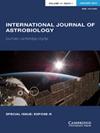Fungal biomarkers are detectable in Martian rock-analogues after space exposure: implications for the search of life on Mars
IF 1
4区 物理与天体物理
Q3 ASTRONOMY & ASTROPHYSICS
引用次数: 7
Abstract
Mars is a primary target of astrobiological interest: its past environmental conditions may have been favourable to the emergence of a prebiotic chemistry and, potentially, biological activity. In situ exploration is currently underway at the Mars surface, and the subsurface (2 m depth) will be explored in the future ESA ExoMars mission. In this context, BIOlogy and Mars EXperiment was performed to evaluate the stability and detectability of organic biomarkers under space and Mars-like conditions. Our data suggested that some target molecules, namely melanin, azelaic acid and nucleic acids, can be detected even after 16 months exposure to Low Earth Orbit conditions by multidisciplinary approaches. We used the same techniques as onboard the ExoMars rover, as Raman and infrared spectroscopies and gas chromatograph-mass spectrometer, and polymerase chain reaction even if this is not planned for the imminent mission to Mars. These results should be taken into account for future Mars exploration.在太空暴露后,真菌生物标志物在火星岩石类似物中可检测到:对火星生命搜索的影响
火星是天体生物学兴趣的主要目标:它过去的环境条件可能有利于生命前化学和潜在生物活动的出现。火星表面的原位探测目前正在进行中,而地下(2米深)将在未来的ESA ExoMars任务中进行探索。在此背景下,进行了生物学和火星实验,以评估有机生物标志物在太空和类火星条件下的稳定性和可检测性。我们的数据表明,通过多学科方法,即使在低地球轨道条件下暴露16个月后,也可以检测到一些目标分子,即黑色素、壬二酸和核酸。我们使用了与ExoMars探测器相同的技术,如拉曼光谱、红外光谱、气相色谱-质谱仪,以及聚合酶链反应,即使这不是即将到来的火星任务的计划。这些结果应该考虑到未来的火星探测。
本文章由计算机程序翻译,如有差异,请以英文原文为准。
求助全文
约1分钟内获得全文
求助全文
来源期刊

International Journal of Astrobiology
地学天文-地球科学综合
CiteScore
3.70
自引率
11.80%
发文量
45
审稿时长
>12 weeks
期刊介绍:
International Journal of Astrobiology is the peer-reviewed forum for practitioners in this exciting interdisciplinary field. Coverage includes cosmic prebiotic chemistry, planetary evolution, the search for planetary systems and habitable zones, extremophile biology and experimental simulation of extraterrestrial environments, Mars as an abode of life, life detection in our solar system and beyond, the search for extraterrestrial intelligence, the history of the science of astrobiology, as well as societal and educational aspects of astrobiology. Occasionally an issue of the journal is devoted to the keynote plenary research papers from an international meeting. A notable feature of the journal is the global distribution of its authors.
 求助内容:
求助内容: 应助结果提醒方式:
应助结果提醒方式:


